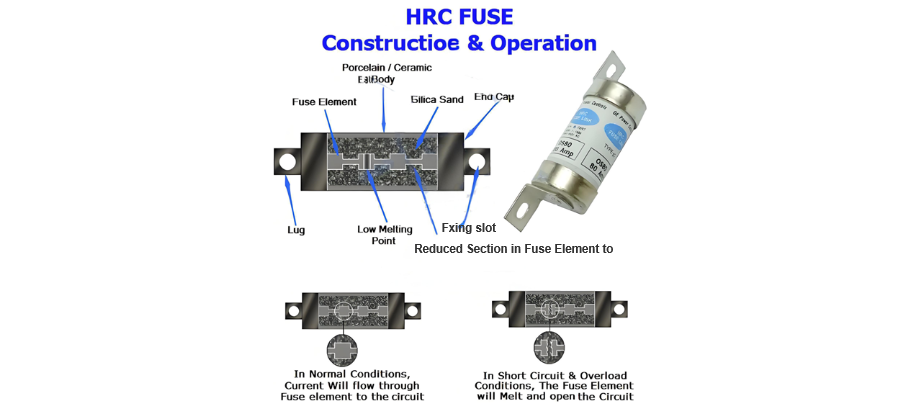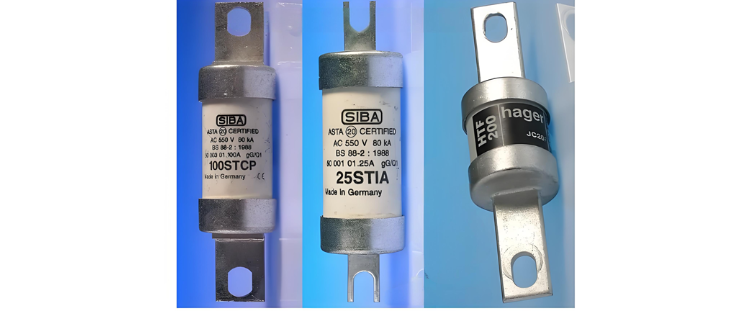HRC Fuse (High Rupturing Capacity Fuse) and its Types
Edwiin
05/19/2025


When a fault occurs, the silver fuse element blows first, and the current is transferred to the tungsten wire. The plunger's stroke is designed such that it does not eject from the fuse body during fault conditions.
Advantages of HRC Fuse with Tripping Device
- Single-Phase Fault Protection in Three-Phase Systems:When a single-phase fault occurs in a three-phase system, the plunger trips the circuit breaker, opening all three phases simultaneously to prevent unbalanced single-phase power supply.
- Cost Reduction for Circuit Breakers:By allowing the fuse to handle the primary interruption of fault currents, the circuit breaker only needs to account for the effects of short circuits, enabling the use of less expensive breaker models.
- Reduced Fuse Replacement Frequency:The tripped circuit breaker can handle small currents, eliminating the need to replace the fuse frequently (except in cases of high-current faults).
- High Breaking Capacity Range:Low-voltage HRC fuses are available with breaking capacities ranging from 16,000A to 30,000A at 400V (some models extend to 80kA to 120kA), widely used for overload and short-circuit protection in low-voltage distribution systems.
Types of HRC Fuse
- NH Fuse
- Din Type
- Blade Contact

Disadvantages
Applications
Topics
Hello,I'm Wdwiin. A decade of hands-on experience in electrical engineering, specializing in high-voltage systems, smart grids, and renewable energy technologies. Passionate about technical exchange and knowledge sharing, committed to interpreting industry trends with professional insights to empower peers. Connection creates value—let’s explore the boundless possibilities of the electrical world together!

What is Voltage Stability in Power Systems?
Definition of Voltage StabilityVoltage stability in a power system is defined as the ability to maintain acceptable voltages at all buses under both normal operating conditions and after being subjected to a disturbance. In normal operation, the system’s voltages remain stable; however, when a fault or disturbance occurs, voltage instability may arise, leading to a progressive and uncontrollable voltage decline. Voltage stability is sometimes referred to as "load stability."Voltage instability c
Encyclopedia
07/26/2025

What is Dual Trace Oscilloscope?
What is Dual Trace Oscilloscope?DefinitionA dual-trace oscilloscope uses a single electron beam to generate two separate traces, each deflected by an independent input source. To produce these two traces, it primarily employs two operating modes—alternate mode and chopped mode—controlled by a switch.Purpose of a Dual-Trace OscilloscopeWhen analyzing or studying multiple electronic circuits, comparing their voltage characteristics is often critical. While one could use multiple oscilloscopes for
Encyclopedia
07/25/2025

What is Cathode Ray Oscilloscope (CRO)?
What is Cathode Ray Oscilloscope (CRO)?DefinitionA cathode ray oscilloscope (CRO) is an electrical instrument for measuring, analyzing and visualizing waveforms and other electronic/electrical phenomena. As a high - speed X - Y plotter, it shows an input signal against another signal or time. Capable of analyzing waveforms, transient phenomena and time - varying quantities across a wide frequency range (from very low to radio frequencies), it mainly operates on voltage. Other physical quantities
Edwiin
07/25/2025

What is Automatic Voltage Regulator?
An automatic voltage regulator is employed to regulate voltage, converting fluctuating voltages into a constant one. Voltage fluctuations mainly stem from variations in the load on the supply system. Such voltage variations can damage the equipment within the power system. These fluctuations can be mitigated by installing voltage - control equipment at various locations, such as near transformers, generators, and feeders. Multiple voltage regulators are often placed throughout the power system t
Edwiin
05/22/2025









